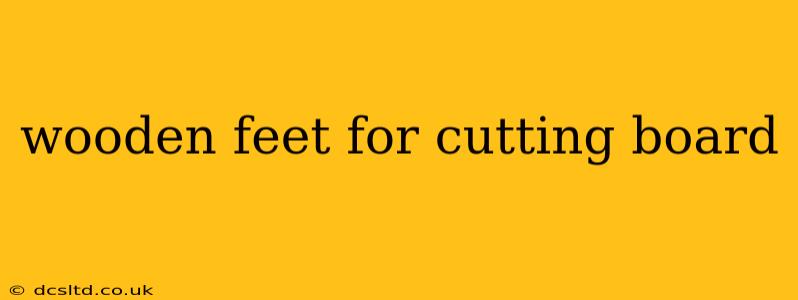Cutting boards are essential kitchen tools, but without proper support, they can easily slip and slide, leading to accidents and potential damage. This is where wooden feet for cutting boards come in. These seemingly small additions significantly improve stability, protect countertops, and even add a touch of elegance to your kitchen. This guide will delve into everything you need to know about wooden feet for cutting boards, from choosing the right ones to installing them effectively.
Why Use Wooden Feet for Your Cutting Board?
Several compelling reasons exist for using wooden feet on your cutting boards:
-
Enhanced Stability: This is the primary benefit. Wooden feet elevate the cutting board, providing a stable base and preventing slippage during use. This is particularly crucial when working with sharp knives or heavy ingredients.
-
Countertop Protection: The feet create a buffer between the cutting board and your countertop, protecting the surface from scratches, knife marks, and potential damage from moisture.
-
Improved Hygiene: Elevating the cutting board allows for better air circulation underneath, which can help prevent the build-up of bacteria and moisture.
-
Added Aesthetic Appeal: Wooden feet can enhance the overall look of your cutting board, adding a touch of rustic charm or modern elegance, depending on the style you choose.
-
Noise Reduction: The feet can dampen the sound of chopping and cutting, making your kitchen experience a little quieter.
What Types of Wooden Feet Are Available?
The market offers a variety of wooden feet for cutting boards, differing in size, shape, and material. Common options include:
-
Small, round feet: These are the most common type and are ideal for smaller cutting boards.
-
Larger, square or rectangular feet: These provide greater stability for larger and heavier cutting boards.
-
Feet with felt pads: Felt pads on the bottom of the feet further enhance stability and prevent scratching on countertops.
-
Different wood types: Feet are often made from various woods, such as maple, cherry, or walnut, allowing you to match them to your cutting board or kitchen décor.
How to Attach Wooden Feet to Your Cutting Board
Attaching wooden feet is a relatively straightforward process. However, the exact method will depend on the type of feet and your cutting board material. Common methods include:
-
Wood glue: A strong wood glue is often sufficient for securely attaching small feet. Ensure the surfaces are clean and dry before applying the glue.
-
Screws: For larger, heavier cutting boards or more robust feet, screws may be necessary to ensure a secure bond. Pre-drill pilot holes to prevent splitting the wood.
-
Dowels: For a more intricate and visually appealing attachment, dowels can be used to join the feet to the cutting board. This requires more woodworking skills.
What Size Wooden Feet Do I Need?
The ideal size of wooden feet depends primarily on the size and weight of your cutting board. As a general guideline:
-
Small cutting boards: Small, round feet (approximately ½ inch to ¾ inch in diameter) will usually suffice.
-
Large cutting boards: Larger, square or rectangular feet (1 inch or larger) will provide greater stability.
Consider the weight of the cutting board and the materials used in its construction when making your selection.
Can I Make My Own Wooden Feet for Cutting Boards?
Yes, you can! With basic woodworking skills and readily available materials, you can create custom wooden feet to perfectly match your cutting board. This allows for greater control over size, shape, and wood type.
Where Can I Buy Wooden Feet for Cutting Boards?
Wooden feet for cutting boards are widely available from various sources, including:
-
Online retailers: Websites such as Amazon, Etsy, and specialized woodworking supply stores offer a wide selection.
-
Local hardware stores: Many local hardware stores carry small wooden feet or components that can be adapted for this purpose.
-
Woodworking shops: Local woodworking shops may offer custom-made wooden feet or provide assistance in creating your own.
By understanding the benefits, types, and installation methods of wooden feet, you can significantly improve the functionality and longevity of your cutting boards while enhancing your overall kitchen experience. Remember to choose feet that are appropriate for the size and weight of your cutting board and to install them securely using the appropriate method.
